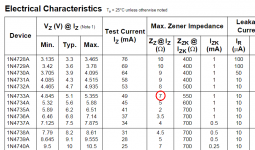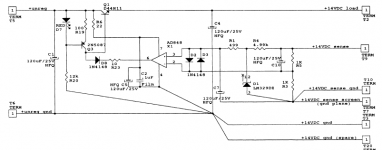Calculate the -3dB rolloff corner frequency when the zener's dynamic output impedance is "R ohms" (from datasheet) and the parallel capacitor is "C=100nF". That's the frequency at which the capacitive bypassing poops out, and ceases shunting the zener noise to ground.
There's a reason why Walt Jung uses an RC ladder filter in the Super Regulator instead of a bare naked capacitorr.
_
There's a reason why Walt Jung uses an RC ladder filter in the Super Regulator instead of a bare naked capacitorr.
_
Attachments
Just so folks get the reference -- from "High Performance Regulators, Part 3" :There's a reason why Walt Jung uses an RC ladder filter in the Super Regulator instead of a bare naked capacitorr.
Attachments
Have you seen this circuit? It's not particularly cheap, however.Your assumption is not quite correct. I do intend to use it for instrumentation purposes 🙂
So I need low noise as well as a decent precision and stability. But the precision and stability does not have to be at the LTC6655 level. And of course I would prefer a significantly lower cost.
https://www.pearl-hifi.com/06_Lit_A...W/Build_Ultra_Low_Noise_Voltage_Reference.pdf
I have now received the SPX2431 and made some measurements.I am looking at various options to implement a voltage reference for ADC's and DAC's.
One of the options is to use an LM431/TL431 + filter + buffer.
For this I have searched for '431's with low noise, reducing the requirements for the filter.
In the table in post #497 link and indeed in the datasheet (curve) from onsemi, the noise is specified as 48 nV/sqrt(Hz).
Has anyone here or somewhere else been able to confirm this number?
I have just made some measurements, where I got a noise of around 123 nV/sqrt(Hz).
This was with the TL431BCLPRMG (TO-92) from onsemi.
The noise was calculated from a total noise of around 18.2 uV over a 22 kHz BW.
Interestingly, the noise spectrum was flat, with no 1/f noise visible down to 10 Hz.
With the LM431SBCM3X (SOT23) the total noise was slightly lower at 16.5 uV, equal to 112 nV/sqrt(Hz).
The 1/f corner was around 100 Hz.
For the LM431 the noise is not specified. Only mentioned under features as "Low Output Noise Voltage".
One of my goals was to find out if the TL431 and LM431 from onsemi were comparable, since no noise data is available in the datasheet of the LM431.
I have seen mentioned before that the onsemi versions should have lower noise than comparable '431 devices, but the values I measured seem to be similar to the approximately 125 nV/sqrt(Hz) specified by TI.
I measured a noise of 11.8 uV, equal to 79.6 nV/sqrt(Hz) at a current of 1.1 mA. The noise at 10 Hz was only around 3 dB higher than at 1 kHz.
At 10 mA the noise increases a little (as it was also the case with the onsemi devices), to 12.2 uV, equal to 82.3 nV/sqrt(Hz).
Again, it is far from the datasheet value of around 38 nV/sqrt(Hz).
The noise was measured using audioTester 3.0 by the way.
So, the noise of the Sipex/MaxLinear SPX2431 does seem to be around 3 dB lower than the noise of the onsemi devices.
I have only measured one device of each type, so the statistical evidence is a bit thin of course 🙂
Would your application tolerate the insertion of a 2nd order lowpass active filter, between the TL431-equivalent and the regulator's error amplifier? You could exploit the low output impedance of the active filter, by then connecting a passive 0.8Hz lowpass (using 1K and 220uF) between filter opamp and regulator VREF input terminal. 1K gives 4 nV/rtHz .
I expect to use an op-amp + buffer to drive the Vref of the converter, so a filter can and will definitely be inserted. Whether I need an active filter or just a passive first order filter is TBD.
Then buy the 275 nV / rtHz version of the TL431 and filter out the noise as aggressively as you please.
In principle that would work of course. But there are probably some compromises in terms of DC accuracy, complexity or something else that will make it complex. So starting with a relatively low noise level will make it easier, particularly at low frequencies, which are of course more difficult to clean with a filter.
Sallen Key 2nd order LPF using R1=R2=1K and C1=C2=33uF. f0 = 4.8 Hz , Q = 0.5 (damping zeta = 1.0), noise resistance = 2K.
If you have enough board area, you could make your own Hilbiber-style bandgap reference, see for noise measurements of the one I made https://www.diyaudio.com/community/threads/return-to-zero-shift-register-firdac.379406/post-6943225 You probably have to tweak a resistance ratio to trim out the first-order temperature dependence.In principle that would work of course. But there are probably some compromises in terms of DC accuracy, complexity or something else that will make it complex. So starting with a relatively low noise level will make it easier, particularly at low frequencies, which are of course more difficult to clean with a filter.
@JensH ,did you see the schematic with the LT6200 at the end of the GLED431 pdf? and one more thing about the reference filter
https://refsnregs.waltjung.org/GLED431_An%20Ultra%20Low%20Noise%20LED%20Reference%20Cell%20_Walt's%20Blog%202014_092418.pdf
https://refsnregs.waltjung.org/An_Improved_Reference_Filter_for_Audio_Regulators.pdf
https://refsnregs.waltjung.org/GLED431_An%20Ultra%20Low%20Noise%20LED%20Reference%20Cell%20_Walt's%20Blog%202014_092418.pdf
https://refsnregs.waltjung.org/An_Improved_Reference_Filter_for_Audio_Regulators.pdf
Thanks for your inputs.
I think that with filtering I can get sufficiently low noise and a low drift with an LM/TL431 and slightly lower noise with the SPX2431.
I have made some simulations and it seems like a first order filter with e.g., 10k and 22 uF + an OPA1612 buffer will achieve a lower noise level than the LT3042, even with a TI TL431. At low frequencies the SPX2431 should achieve a slightly lower noise. At high frequencies it will be dominated by the op-amp.
I plan to make the filter with two capacitors in series and a resistor to the midpoint to almost eliminate the leakage current of the capacitor as done in Walt Youngs Ultra Low-Noise Voltage Reference.
I think that with filtering I can get sufficiently low noise and a low drift with an LM/TL431 and slightly lower noise with the SPX2431.
I have made some simulations and it seems like a first order filter with e.g., 10k and 22 uF + an OPA1612 buffer will achieve a lower noise level than the LT3042, even with a TI TL431. At low frequencies the SPX2431 should achieve a slightly lower noise. At high frequencies it will be dominated by the op-amp.
I plan to make the filter with two capacitors in series and a resistor to the midpoint to almost eliminate the leakage current of the capacitor as done in Walt Youngs Ultra Low-Noise Voltage Reference.
That was my conclusion as well, and I use filtered TL431 reference in the low noise voltage regulator. However, 10 KΩ/22 uF is not enough to filter low frequency noise.I have made some simulations and it seems like a first order filter with e.g., 10k and 22 uF + an OPA1612 buffer will achieve a lower noise level than the LT3042, even with a TI TL431.
Here are some measurements using LNA with 0.445 nV/sqrt(Hz). Capacitors are Nichicon UKZ 33 uF/50V and Nichicon FM 330 uF/35V. Respective measured leakage currents at 2.5 V were 0.33 pA and 1 pA. Measurements were made with 44.1 kHz sampling rate. With 33 uF, total noise is considerably higher due LF noise contribution.
With 330 uF, noise is almost the same as LNA noise floor which produces 68 nV noise (22 -22 kHz).
Seems like you could get a lot of mileage out of a dual opamp and 2 resistors and 2 capacitors. Or add two more leak-prevention resistors if you wish.
I verified suspiciously low leakage of Nichicon Panasonic FM 330 uF/35V. There was 3 remaining in the bag and all have 1 -2 pA leakage at 2.5 V. I don’t know whether that is “golden batch”, as other various FM/FC series capacitors in 120 uF – 220 uF and 35/50 V range has an order of magnitude higher leakage, or this is usual for this specific capacitor.
The specified leakage is equivalent to a leakage time constant of 100 seconds, measured two minutes after applying the voltage. For 2.5 V, 100 uF, that boils down to 2.5 uA, so 20 pA is also many orders of magnitude less than specified.
Datasheet specified leakage numbers are for the absolute worst conditions (tolerance, max. temp. and voltage). Actual leakage numbers for room temperature and fraction of rated voltage are, IME, up to two orders of magnitude lower. Measured leakage numbers were obtained 5 min. after applying voltage.
@Mark Johnson
I just modified the simulated circuit to a sallen-key with the component values you suggested. It gave a fairly nice noise level. I then changed the resistors to 5k, which reduces the noise to almost the level determined by the OPA1612. After that I changed the circuit to use the OPA1612 based buffer (that I had already) as the op-amp in the filter. In simulation that works fine.
If I need to make some leak-prevention I assume that I only need that on the capacitor connected to ground, since the DC voltage across the other one should ideally be 0.
The lowest frequency of interest is somewhere below 20 Hz. It is for test equipment, so in principle as low as possible, but of course there will be a diminishing return of investment somewhere. And other noise sources will dominate at some point.
I can live with a settling time of a few seconds, but it seem like the filter you suggested settles relatively fast.
I just modified the simulated circuit to a sallen-key with the component values you suggested. It gave a fairly nice noise level. I then changed the resistors to 5k, which reduces the noise to almost the level determined by the OPA1612. After that I changed the circuit to use the OPA1612 based buffer (that I had already) as the op-amp in the filter. In simulation that works fine.
If I need to make some leak-prevention I assume that I only need that on the capacitor connected to ground, since the DC voltage across the other one should ideally be 0.
The lowest frequency of interest is somewhere below 20 Hz. It is for test equipment, so in principle as low as possible, but of course there will be a diminishing return of investment somewhere. And other noise sources will dominate at some point.
I can live with a settling time of a few seconds, but it seem like the filter you suggested settles relatively fast.
- Home
- Amplifiers
- Power Supplies
- Are you really fine with IC voltage regulators ?

